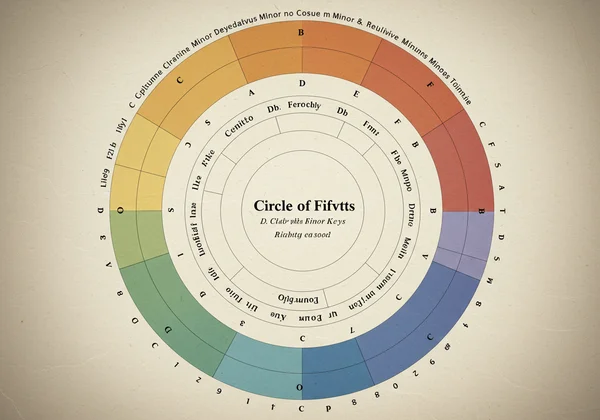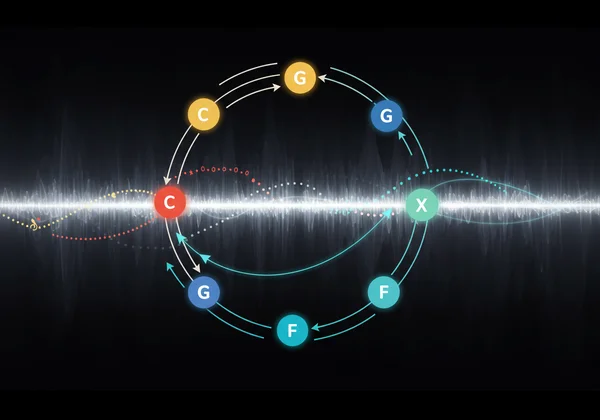Why Your Song Bridge Sounds Weak: A Circle of Fifths Solution
That feeling is all too familiar for songwriters. The verse is solid, the chorus is an earworm, but the bridge… it just falls flat. It feels disconnected, boring, or worse, it derails the entire momentum of your song. If you're struggling with how to write a song bridge that truly elevates your music, you're not alone. But what if the secret to a powerful, emotionally resonant bridge was hiding in plain sight, within a single, elegant diagram?
The Circle of Fifths isn't just a dry piece of music theory; it's a dynamic map for musical storytelling. It’s the key to unlocking compelling transitions, creating unforgettable emotional shifts, and transforming a weak bridge into the most impactful moment of your song. Let’s dive into how you can use this incredible tool to fix your bridges for good. You can follow along and test every concept using this interactive music tool.

Common Songwriting Mistakes in Bridge Design
Before we build, we must understand what’s broken. A weak bridge often stems from a few common missteps that disrupt the song's flow. Identifying these is the first step toward crafting something truly special. Many songwriters simply don’t know where to go after the second chorus, leading to a bridge that feels like an afterthought.
Recognizing a disconnected or underwhelming bridge
Does your bridge sound like it belongs to a different song? This often happens when the harmonic shift is too abrupt or seemingly random. An underwhelming bridge, on the other hand, fails to create a new perspective. It meanders without purpose and doesn't build any anticipation, making the listener feel like the song is just treading water before the final chorus. It lacks a clear musical or lyrical purpose, failing to offer a fresh angle on your song’s central theme.

The pitfalls of repetition without musical evolution
Another common trap is simply repeating chords from the verse or chorus but with different lyrics. While familiarity is comfortable, a bridge's job is to provide contrast. Without harmonic evolution, the bridge loses its power to surprise and re-engage the listener. It should feel like a journey to a new place, not just a detour through the same neighborhood. A great bridge should introduce a new harmonic color that makes the return to the chorus feel even more satisfying.
Building a Strong Bridge: The Songwriting Structure Approach
To fix a weak bridge, we must first appreciate its fundamental role. It's not just filler material; it's a crucial part of the narrative arc of your song. Think of it as the plot twist in a movie or the moment of reflection before the final act.
Understanding the bridge's essential role in song structure
A bridge has three primary functions: providing lyrical contrast, introducing harmonic variation, and building tension that resolves powerfully in the final chorus. It’s your chance to shift the perspective, ask a question, or reveal a deeper truth. Musically, it breaks the pattern established by the verse-chorus cycle, making the song more dynamic and engaging. By understanding this, you can start using the Circle of Fifths not as a set of rules, but as a creative guide to explore key changes and build that perfect moment.
Strategy 1: The Art of Music Modulation with the Circle
Modulation, or changing keys, is one of the most effective ways to make a bridge feel like a distinct and exciting section. The Circle of Fifths is your ultimate roadmap for navigating these key changes smoothly.
Smooth key changes by stepping around the circle
The keys located next to each other on the Circle of Fifths are closely related, sharing most of the same notes. This makes them perfect candidates for subtle and effective modulations. For example, if your song is in C Major, moving to its neighbors G Major (one step clockwise) or F Major (one step counter-clockwise) for the bridge creates a noticeable but pleasant shift. This gentle harmonic lift or relaxation can perfectly complement a change in lyrical tone.
Practical modulation examples for dynamic bridge transitions
Let’s say your song is in G Major. The V chord is D Major. By making that D Major chord a new temporary tonic, you can modulate to the key of D for the bridge. This move is incredibly powerful and common in popular music. Using an interactive Circle of Fifths chart, you can instantly see these relationships. Click on G Major, and you’ll see D Major is right next door. This visual aid removes the guesswork and empowers you to experiment with confidence.

Strategy 2: Creating Tension and Release with Dominant Chords
A great bridge builds anticipation, making the listener crave the return of the chorus. The Circle of Fifths helps you master this by leveraging the powerful relationship between dominant and tonic chords.
Secondary dominants and the circle's gravitational pull
Every major and minor chord within a key has its own dominant chord (the V chord of its own key). Using one of these "secondary dominants" creates a strong pull towards a chord other than the tonic. For instance, in C Major, the ii chord is D minor. The dominant of D minor is A7. Dropping an A7 chord into your bridge creates a powerful urge to resolve to D minor, adding a surprising and sophisticated harmonic twist. The Circle of Fifths helps you find these secondary dominants instantly, showing you how each chord relates to the next.
Building anticipation for a powerful chorus return
The ultimate goal of bridge tension is to make the final chorus feel like a triumphant homecoming. The most powerful way to do this is by ending your bridge on the song’s true V chord. If your song is in C Major, ending the bridge on a G7 chord creates an almost unbearable need to hear the C Major of the chorus. This tension-and-release dynamic is the cornerstone of satisfying songwriting, and the Circle is your guide to perfecting it. Master chord progressions by visualizing this gravitational pull.
Strategy 3: Exploring Relative and Parallel Minor Bridges
Sometimes, the most effective bridge is one that completely changes the emotional landscape of the song. The Circle of Fifths beautifully illustrates the relationships between major and minor keys, giving you simple tools for profound emotional shifts.
Shifting moods with relative minor/major keys
Every major key on the Circle of Fifths has a relative minor, found just inside the circle. For C Major, it’s A minor. These keys share the exact same key signature, making a transition between them seamless yet emotionally impactful. Shifting from an upbeat C Major verse/chorus to a more introspective A minor bridge can add incredible depth to your story. It’s a classic songwriting technique that feels fresh every time.
The impact of parallel key borrowing for unique harmony
For a more dramatic and modern sound, try borrowing chords from the parallel minor. If your song is in C Major, the parallel minor is C minor. Chords from C minor, like Ab Major, Eb Major, and F minor, can be "borrowed" and used in your C Major bridge. This technique, called modal interchange, adds a rich, cinematic quality to your music. An online theory tool can help you quickly identify the chords in both the major and parallel minor keys, opening up a new world of harmonic color.

Transform Your Song Bridges Today with the Interactive Circle of Fifths
A weak bridge doesn't have to be the downfall of your song. By understanding its purpose and leveraging the power of the Circle of Fifths, you can craft transitions that are dynamic, emotionally resonant, and unforgettable. Whether you’re modulating to a nearby key, creating tension with dominant chords, or shifting the mood with minor keys, this timeless tool provides the map.
Stop guessing and start designing your bridges with intention. The best way to learn is by doing. Go to the Circle of Fifths tool right now. Click on your song's key, and explore all the possibilities we've discussed. See the relationships, hear the chords, and unlock the potential of your songwriting today.
Frequently Asked Questions About Song Bridges and the Circle of Fifths
How can the Circle of Fifths help me write a better song bridge?
The Circle of Fifths provides a visual map of key relationships, helping you find harmonically pleasing key changes (modulation), create tension with dominant chords to make your chorus hit harder, and explore emotional shifts by moving to relative or parallel minor keys. It turns abstract theory into an actionable songwriting strategy.
What are common mistakes to avoid when writing a song bridge?
The most common mistakes are making the bridge sound musically disconnected from the rest of the song, or making it too repetitive by using the same chords as the verse or chorus. A bridge should provide contrast and build momentum, not stall it.
Can the Circle of Fifths help with other songwriting challenges?
Absolutely! Beyond bridges, it's a foundational tool for writing entire chord progressions, understanding key signatures instantly, transposing songs to different keys, and even generating ideas for melodies. It's a Swiss Army knife for any songwriter looking to deepen their understanding of music theory.
Where can I practice these bridge-writing techniques interactively?
The best place to practice is with a hands-on tool. On the Circle of Fifths homepage, you can click any key to instantly see its related chords, relative minor, and neighbors on the circle. You can even hear the chords, making it the perfect environment to experiment with the strategies in this article.